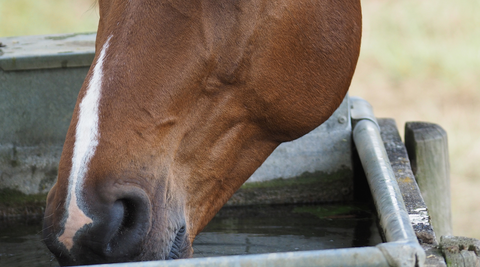Dehydration

Dehydration: When the body loses more water than it takes in.
Just 1% dehydration can cause a loss in performance, but severe dehydration can be life threatening.
When horses sweat they lose water and electrolytes. Horses can lose approximately 5 to 7 litres of sweat (containing 50-70g of electrolytes) when in moderate work, trotting and cantering. Sweat losses increase as exercise intensity or duration increases or in hot and humid weather. A horse working hard that is dripping sweat above the eyes and under the belly can be estimated to have lost 12 to 18 litres of sweat (containing 120-180 g of total electrolytes).
Maintaining hydration and replacing lost electrolytes is important not only for competition horses, but all horses and ponies who are sweating after work or travel. Just offering water is not sufficient, electrolytes need to be replaced at the correct concentrations to ensure that the desire to drink Is maintained, so fluid balance and electrolyte losses can be restored, to promote recovery, and ensure optimum performance.
How can I tell if my horse is dehydrated?
There are a few ways this can be done, firstly monitor their water intake by simply checking how much they have drunk from their water bucket. This can be difficult with automatic waterers or when turned out in groups.
You can also monitor urine output. Dark urine or an overall lack of urine can indicate dehydration.
Another test is to look at the gums, including capillary refill test. Please ensure your safety when looking in a horse’s mouth! Gently lift the lip and look at the gums, they should be salmon pink and moist. If you then press on the gum with a finger and lift off, count the time it takes to return from white back to pink, ideally this should be less than 2 seconds. Longer than 2 seconds can indicate dehydration. Dark pink or red, dry gums can also be an indicator of dehydration.
The skin pinch test is another test, but this is not always reliable. To use this test, pinch a bit of skin on the neck, release and it should ping back immediately. By the time the skin stays tented dehydration is often quite advanced and we would recommend the other methods of checking hydration first.
 Skip to content
Skip to content

